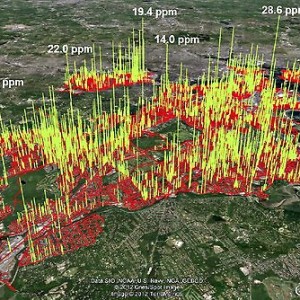BOSTON UNIVERSITY DEPARTMENT OF EARTH AND ENVIRONMENT
Natural gas is the largest source of anthropogenic emissions of methane (CH4) in the United States. To assess pipeline emissions across a major city, we mapped CH4 leaks across all 785 road miles in the city of Boston using a cavity-ring-down mobile CH4 analyzer. We identified 3356 CH4 leaks with concentrations exceeding up to 15 times the global background level. Separately, we measured δ13CH4 isotopic signatures from a subset of these leaks. The δ13CH4 signatures (mean = −42.8‰ ± 1.3‰ s.e.; n = 32) strongly indicate a fossil fuel source rather than a biogenic source for most of the leaks; natural gas sampled across the city had average δ13CH4 values of −36.8‰ (±0.7‰ s.e., n = 10), whereas CH4 collected from landfill sites, wetlands, and sewer systems had δ13CH4 signatures ∼20‰ lighter (μ = −57.8‰, ±1.6‰ s.e., n = 8). Repairing leaky natural gas distribution systems will reduce greenhouse gas emissions, increase consumer health and safety, and save money.
Download full report (ScienceDirect.com): Mapping Urban Pipeline Leaks: Methane Leaks Across Boston
About the Boston University Department of Earth & Environment
www.bu.edu/earth/
“The Department of Earth & Environment is the nexus of research, education, and outreach related to Planet Earth at Boston University. This vision includes the physics and chemistry of the Earth’s solid earth and climate system, the ecology and biogeochemistry of terrestrial and marine ecosystems, and the dynamic interactions of people and society with the natural environment on local, regional, and global scales.
Our research and teaching foci include both disciplinary foundations and interdisciplinary themes, and are explicitly designed to be outward looking and inclusive of the broad mosaic of Earth & Environment-related units, programs, and activities at Boston University.”
Tags: Boston, Boston University, Boston University Department of Earth & Environment, BU, MA, Massachusetts, Natural Gas







 RSS Feed
RSS Feed